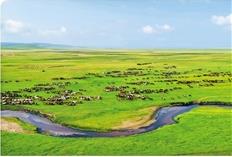Inner Mongolia: Green Development of Economic Soaring and Writing a New Chapter of "Model Autonomous Region"

The scenery of Nailin Gaole grassland in Dongwuzhumuqin Banner, Inner Mongolia. Xinhua News Agency reporter Ren Junchuan photo

Employees check the milk packaging on the liquid milk production line of Yili Group in Hohhot. Xinhua News Agency reporter Peng Yuanshe
Based on ecological protection, Inner Mongolia has built a green development strategy, accelerated economic transformation and upgrading, optimized regional development layout and achieved high-quality development. Over the past 70 years, the economic scale of Inner Mongolia has been continuously expanded, the economic structure has been more reasonable, the growth momentum has been abundant and strong, the fiscal revenue has been steadily expanded, and various undertakings have made great progress.
In August, in Inner Mongolia prairie, sometimes the sky is high and the clouds are wide, the sheep are slow, the horses neigh, the camel bells jingle, and sometimes the rainbow is connected with the rain, and the grass gleams in the sunshine under the clouds — — This is the best season of the year, and it is the most beautiful scenery in the north of the motherland.
Regional ethnic autonomy in Inner Mongolia Autonomous Region was first realized in China, and it was praised as "model autonomous region" in 1950s. Since then, despite twists and turns, I have always been firm in my faith and devoted myself to development, and finally moved towards a prosperous, strong, beautiful and harmonious new life today.
Riding on a gallop to achieve takeoff
Over the past 70 years, the people of all ethnic groups in Inner Mongolia have worked hand in hand to forge ahead, always holding high the banner of great unity among ethnic groups, creating many first and valuable experiences in the history of ethnic work in New China, and writing historical stories such as "Qi Xin cooperated to build Baotou Steel", "3,000 orphans went to Inner Mongolia", "Overcoming difficulties and donating grain and livestock" and "The best pasture is aerospace". National unity is like the sunshine on the grassland, nourishing the happy life of brothers and sisters of all ethnic groups.
Over the past 70 years, the economic development of Inner Mongolia has achieved earth-shaking changes. In 2018, the total economic output and per capita GDP reached 1.7 trillion yuan and 68,000 yuan respectively, an increase of 595 times and 137 times compared with 70 years ago. Since the beginning of the new century, under the favorable situation of a series of preferential policies such as the national western development and the concentration of various development advantages in Inner Mongolia, the economy of Inner Mongolia has taken off, constantly catching up and surpassing, and the three industries have been constantly optimized and rational, from 76.7∶7.1∶16.2 in 1947 to 10.1∶39.4∶50.5 in 2018.
In 1959, Baotou Steel’s No.1 blast furnace was completed and the first beautiful iron flower flowed out, ending the history of being barren in the border ethnic minority areas of Inner Mongolia. Today, Baotou, the "Grassland Steel City", has the largest enterprises in Inner Mongolia, such as steel, aluminum, equipment manufacturing and rare earth processing, and has become the 20 most suitable cities for industrial development and the 50 best cities in the investment environment.
Ordos, which also regards industry as its backbone, has successfully embarked on a development path that deals with the transformation of industrial scale and industrial value chain, industrial specialization and diversification, and comparative advantage and competitive advantage from "one coal dominates" to industrial diversification. During the "Twelfth Five-Year Plan" period, the total industrial output of Ordos has always been the top spot in Inner Mongolia Autonomous Region, accounting for more than 30%.
The transformation and upgrading will spread a new picture of grassland culture in the whole region. Hohhot has become the largest cloud computing data center in China. With suitable climate, geographical conditions and abundant power supply, data centers have been built and put into use in Qingcheng, expecting Hohhot to become a "Cloud Valley of China".
With the development of economy and society and the remarkable improvement of people’s living standards, modern new cities have sprung up in the field of Senecio scandens. People bid farewell to the history of "adobe houses and Lele cars". Nowadays, most administrative villages in the whole region have achieved social undertakings such as no dangerous houses, safe drinking water, hardened streets and lanes, electricity, radio, television and internet, standardized clinics, cultural activity rooms and convenience supermarket chains, and all the permanent residents in agricultural and pastoral areas have been included in social undertakings such as old-age medical care and minimum living security. Some herders and hunters who have kept their traditional nomadic and hunting life have also realized household electricity supply. Residents in agricultural and pastoral areas are no longer satisfied with eating and drinking enough, but are considering how to be greener and healthier … …
Ecological priority of Chunhua Qiushi
Inner Mongolia spans northeast, north and northwest. This vast land, where forests, grasslands, wetlands, rivers, lakes, deserts and other natural forms coexist, is the largest and most complete ecological function area in northern China and an important ecological defense line in the "Three North" region.
Ecological priority and green development have become the strategic arrangements for the development of Inner Mongolia in the new period. On the one hand, the whole region actively explores the establishment of a sustainable ecological environment protection system, on the other hand, it integrates the construction of ecological civilization into the development process of various undertakings. Green has not only become the background color of Inner Mongolia’s ecology, but also become the concept of development in all walks of life.
In summer, Xilin Gol grassland is rich in water plants, and snow-white sheep stroll in the depths of the grassland like pearls, attracting countless tourists to visit.
After years of practice, in 2019, the total area of grazing suspension in Xilin Gol League reached more than 220 million mu, and more than 160 million yuan of grazing suspension subsidies were granted to farmers and herdsmen. Grazing moratorium has been a task that must be resolutely implemented every year on the grassland. Protecting green is the greatest responsibility and has the greatest potential. RiGen Wu Bajard, deputy director of Ximeng Ecological Protection Committee, said: "The implementation of grazing suspension during the green-returning period in spring can effectively avoid the problems of grassland productivity decline and population degradation caused by premature grazing and trampling of pasture growing points by livestock, and can also prevent livestock from running green in spring and reduce the fat loss rate, which is conducive to the transformation of traditional animal husbandry production mode to modern animal husbandry management."
"With subsidies, it is better. Even without subsidies, we have to do a good job of grazing." Renhua Na, a herdsman in Narenbaolige Gacha, Arshanbaolige Town, Xilinhot City, actively reduced the number of sheep to more than 200, but the number of cattle increased to more than 50.
There are fewer sheep because herders have adjusted the herd structure, promoted the structural reform of the supply side of animal husbandry under the guidance of the local government, and vigorously implemented the strategy of "reducing sheep and increasing cattle". Through the grazing moratorium, Renhua Na was delighted to find that, despite a significant increase in income, the grassland has also been significantly restored. Last autumn, the grass planted in his own grassland was enough for his own livestock, and some of it was sold.
Hulun Lake is a pearl on Hulun Buir grassland. Near the east coast, there is a comprehensive ecological environment management and demonstration area in Hulun Lake basin, and three kinds of seedlings, Achnatherum splendens, Leymus chinensis and Artemisia chabaga, grow alternately on the sand.
In the spring of 10 years ago, what the reporter once saw here was that the primary grass buds were covered with white snow, and the eyes were full of yellow sand, but now it is very different. "Because there are many winds along the coast of Hulun Lake, the survival rate of seedlings planted before is less than half. After planting seedlings last year, irrigation after cultivation was carried out with micro-spraying belt. " Jiang Zhiguo, director of the Hulun Lake National Nature Reserve Administration, said, "After ecological management, the problem of sand being blown into the lake can be reduced."
Water environmental pollution, the problem is in the water, the source is on the shore, and the root is in the industry. A series of comprehensive ecological management such as Hulun Lake, Daihai Lake and Wuliangsuhai Lake is not only the improvement of water quality, but also a green development road focusing on transformation.
The high-quality development of Inner Mongolia is based on the protection of ecology and the construction of a green development strategy. After years of development, the whole region has fully realized that the relationship between economic development and ecological environment protection should be correctly handled, and temporary economic growth should never be exchanged at the expense of the environment. Only by taking greening as the guide, accelerating economic transformation and upgrading, and optimizing regional development layout can we build an important ecological security barrier in northern China.
To this end, Inner Mongolia insists on promoting industrial upgrading, guiding, encouraging and supporting the extension of resource-based industrial chains, and actively developing non-resource-based industries; Make the scale of green industry bigger and stronger, and gradually build an efficient, clean, low-carbon and circular green development industrial system; Build a market-oriented green scientific and technological innovation system, coordinate superior scientific and technological resources, overcome technical bottlenecks, and build basic research — Technology research and development — The ecological comprehensive management system of industrial development provides scientific and technological support for ecological priority and green development; Strengthen the control of water, soil and air pollution, make comprehensive policies, make up for shortcomings, and provide resource guarantee for the ecological priority green development of the whole region. (Economic Daily China Economic Net reporter Yan Rong Chen Li)